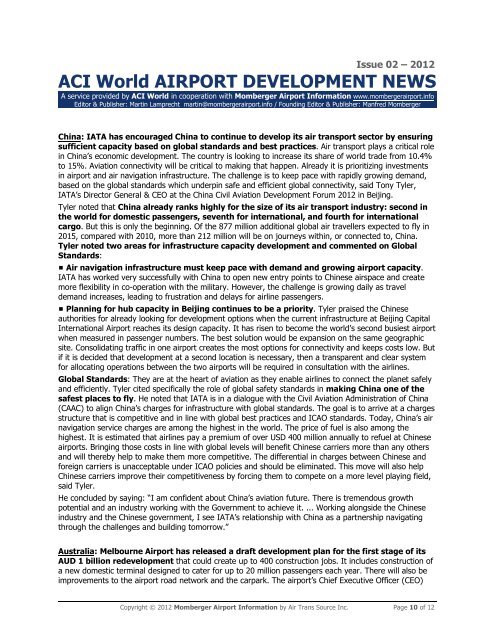ACI World AIRPORT DEVELOPMENT NEWS
ACI World AIRPORT DEVELOPMENT NEWS
ACI World AIRPORT DEVELOPMENT NEWS
Create successful ePaper yourself
Turn your PDF publications into a flip-book with our unique Google optimized e-Paper software.
Issue 02 – 2012<br />
<strong>ACI</strong> <strong>World</strong> <strong>AIRPORT</strong> <strong>DEVELOPMENT</strong> <strong>NEWS</strong><br />
A service provided by <strong>ACI</strong> <strong>World</strong> in cooperation with Momberger Airport Information www.mombergerairport.info<br />
Editor & Publisher: Martin Lamprecht martin@mombergerairport.info / Founding Editor & Publisher: Manfred Momberger<br />
China: IATA has encouraged China to continue to develop its air transport sector by ensuring<br />
sufficient capacity based on global standards and best practices. Air transport plays a critical role<br />
in China’s economic development. The country is looking to increase its share of world trade from 10.4%<br />
to 15%. Aviation connectivity will be critical to making that happen. Already it is prioritizing investments<br />
in airport and air navigation infrastructure. The challenge is to keep pace with rapidly growing demand,<br />
based on the global standards which underpin safe and efficient global connectivity, said Tony Tyler,<br />
IATA’s Director General & CEO at the China Civil Aviation Development Forum 2012 in Beijing.<br />
Tyler noted that China already ranks highly for the size of its air transport industry: second in<br />
the world for domestic passengers, seventh for international, and fourth for international<br />
cargo. But this is only the beginning. Of the 877 million additional global air travellers expected to fly in<br />
2015, compared with 2010, more than 212 million will be on journeys within, or connected to, China.<br />
Tyler noted two areas for infrastructure capacity development and commented on Global<br />
Standards:<br />
# Air navigation infrastructure must keep pace with demand and growing airport capacity.<br />
IATA has worked very successfully with China to open new entry points to Chinese airspace and create<br />
more flexibility in co-operation with the military. However, the challenge is growing daily as travel<br />
demand increases, leading to frustration and delays for airline passengers.<br />
# Planning for hub capacity in Beijing continues to be a priority. Tyler praised the Chinese<br />
authorities for already looking for development options when the current infrastructure at Beijing Capital<br />
International Airport reaches its design capacity. It has risen to become the world’s second busiest airport<br />
when measured in passenger numbers. The best solution would be expansion on the same geographic<br />
site. Consolidating traffic in one airport creates the most options for connectivity and keeps costs low. But<br />
if it is decided that development at a second location is necessary, then a transparent and clear system<br />
for allocating operations between the two airports will be required in consultation with the airlines.<br />
Global Standards: They are at the heart of aviation as they enable airlines to connect the planet safely<br />
and efficiently. Tyler cited specifically the role of global safety standards in making China one of the<br />
safest places to fly. He noted that IATA is in a dialogue with the Civil Aviation Administration of China<br />
(CAAC) to align China’s charges for infrastructure with global standards. The goal is to arrive at a charges<br />
structure that is competitive and in line with global best practices and ICAO standards. Today, China’s air<br />
navigation service charges are among the highest in the world. The price of fuel is also among the<br />
highest. It is estimated that airlines pay a premium of over USD 400 million annually to refuel at Chinese<br />
airports. Bringing those costs in line with global levels will benefit Chinese carriers more than any others<br />
and will thereby help to make them more competitive. The differential in charges between Chinese and<br />
foreign carriers is unacceptable under ICAO policies and should be eliminated. This move will also help<br />
Chinese carriers improve their competitiveness by forcing them to compete on a more level playing field,<br />
said Tyler.<br />
He concluded by saying: “I am confident about China’s aviation future. There is tremendous growth<br />
potential and an industry working with the Government to achieve it. ... Working alongside the Chinese<br />
industry and the Chinese government, I see IATA’s relationship with China as a partnership navigating<br />
through the challenges and building tomorrow.”<br />
Australia: Melbourne Airport has released a draft development plan for the first stage of its<br />
AUD 1 billion redevelopment that could create up to 400 construction jobs. It includes construction of<br />
a new domestic terminal designed to cater for up to 20 million passengers each year. There will also be<br />
improvements to the airport road network and the carpark. The airport’s Chief Executive Officer (CEO)<br />
Copyright © 2012 Momberger Airport Information by Air Trans Source Inc. Page 10 of 12

















